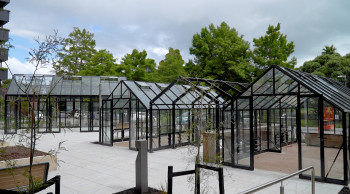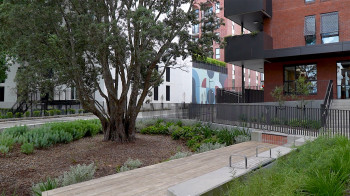Density and amenity go hand in hand
8 Paengawhāwhā 2025
Sue Evans, urban designer for our flagship Community Lane development in Avondale, talks about the design elements that are helping turn the medium-density development into a community.
It is safe to say that in New Zealand, medium to high-density development is still a relatively new concept, and one many people aren’t particularly comfortable with. Often “density” is seen as a dirty word, but in reality, it simply enables more people to live closer to the things they need and like, such as schools, shops, restaurants, workplaces and multi-purpose green spaces.
Done well, density can help create thriving communities; but this doesn’t happen accidentally. It is the deliberate result of good urban design and planning. Density and amenity need to go hand in hand.
Back to the beginning
To help ensure we create thriving communities, at the beginning of the design journey we consider who the development is for - what are their needs, and what do we want them to feel?
For the recently completed Kāinga Ora Community Lane development in Avondale, Auckland, we knew from the outset the majority of the future residents were going to be older or have accessibility needs. We also knew they would likely not have lived in this type of development before, and that a shift to medium density living may be a little daunting. With this in mind, it was always our intention to make Community Lane feel the opposite of a gated community - we wanted the residents to feel a sense of connection, not just to their home but to the wider community. It was important they felt safe here.
One of the first design decisions we made to help accomplish this was to reorientate the service lane to the north. Doing so meant those living in the apartments will have elevated views of the communal gardens, local lane, and for some, the Waitākere Ranges and ocean, helping to enhance feelings of being connected to nature, as well as increasing the sense of safety.
Connection
 Communities don’t thrive if people are living in isolation, which is why it was important for us to find ways and places for residents to foster new connections.
Communities don’t thrive if people are living in isolation, which is why it was important for us to find ways and places for residents to foster new connections.
Each of the five buildings has been designed to have a communal lounge as you enter so residents can enjoy a cup of tea with their family, visitors or perhaps their neighbours; and large communal spaces in the central building can be used to host activities or events. This enables those living there to interact on neutral ground, once again enhancing that feeling of safety and connection.
For those with a green thumb, the complex features three communal greenhouses for residents to use, so they can get to know each other while taking up a new hobby or growing their own kai.
The lane through the development serves to enliven the place by connecting the (aptly named) Community Lane development through to the wider community and the public. It opens the development up to the neighbourhood and facilitates all kinds of future events, such as Sunday markets or Tai chi – whether they are solely for our own residents, for the wider community or any combination of the two.
Accessibility
Accessibility is always a consideration for Kainga Ora when designing a large-scale development, but for Community Lane it was a key area of focus.
 Knowing the majority of residents would be older or have difficulty getting around, the design accommodated ample space for mobility scooter parking both internally and externally, and ensured the lifts were wide enough.
Knowing the majority of residents would be older or have difficulty getting around, the design accommodated ample space for mobility scooter parking both internally and externally, and ensured the lifts were wide enough.
The internal corridors are wider than standard corridors, and there is bench seating and multiple ramps throughout the buildings.
While the lane through the development accommodates cars, we’ve ensured the safety of pedestrians through a dedicated footpath so people can walk the development and surrounds with confidence.
Community Lane is a prime example of how good urban design can foster interaction, and build connections, allowing residents to live independently in a safe environment. We look forward to the new tenants settling in and seeing the community continue to thrive there.
